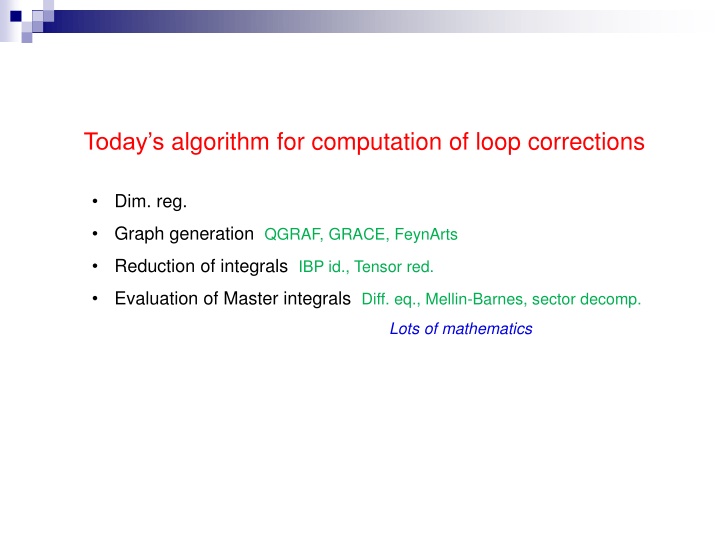
Advanced Techniques in Loop Corrections and Integral Reduction
Explore cutting-edge algorithms and methodologies for computing loop corrections, dimensional regularization, graph generation, integral reduction, and more in high-energy physics calculations. Learn about integration-by-parts identities, reduction of loop integrals to master integrals, and advanced techniques for evaluating master integrals in various dimensions.
Download Presentation

Please find below an Image/Link to download the presentation.
The content on the website is provided AS IS for your information and personal use only. It may not be sold, licensed, or shared on other websites without obtaining consent from the author. If you encounter any issues during the download, it is possible that the publisher has removed the file from their server.
You are allowed to download the files provided on this website for personal or commercial use, subject to the condition that they are used lawfully. All files are the property of their respective owners.
The content on the website is provided AS IS for your information and personal use only. It may not be sold, licensed, or shared on other websites without obtaining consent from the author.
E N D
Presentation Transcript
Todays algorithm for computation of loop corrections Dim. reg. Graph generation QGRAF, GRACE, FeynArts Reduction of integrals IBP id., Tensor red. Evaluation of Master integrals Diff. eq., Mellin-Barnes, sector decomp. Lots of mathematics
Reduction of loop integrals to master integrals Y. Sumino (Tohoku Univ.)
Loop integrals in standard form e.g. A diagram for QCD potential Express each diagram in terms of standard integrals NB: is negative, when representing a numerator. Each can be represented by a lattice site in N-dim. space 1 loop 2 loop 3 loop
Integration-by-parts (IBP) Identities Chetyrkin, Tkachov In dim. reg. Ex. at 1-loop:
(3-loop) 21-dim. space Reduction by Laporta algorithm O
(3-loop) 21-dim. space Reduction by Laporta algorithm O
(3-loop) 21-dim. space Reduction by Laporta algorithm O
(3-loop) 21-dim. space Reduction by Laporta algorithm O
(3-loop) 21-dim. space Reduction by Laporta algorithm O
(3-loop) 21-dim. space Reduction by Laporta algorithm O
(3-loop) 21-dim. space Reduction by Laporta algorithm O
(3-loop) 21-dim. space Reduction by Laporta algorithm O
(3-loop) 21-dim. space Reduction by Laporta algorithm O
(3-loop) 21-dim. space Reduction by Laporta algorithm O Master integrals
Out of only 12 of them are linearly independent. An improvement Evolution in 12-dim. subspace O
Linearly dependent propagator denominators ?1+ ?2+ ?3+ ?4=0 1 ?1?2?3?4 1 1 1 1 + + + = 0 ?2?3?4 ?1?3?4 ?1?2?4 ?1?2?3 1 1 1 1 1 ?1 + + + = 0 2?3?4 2?2?4 2?2?3 ?1?2?3?4 ?1 ?1 ?1 Use to reduce the number of Di s. 1 loop case: ??= ?2+ 2 ?.??+ ?? ; ? = loop momentum ??= external momentum, only up to 4 independent ones. 4 master integrals (well known)
In the case of QCD potential ? 1 loop: 1 master integral 2 loop: 5 master integrals 3 loop: 40 master integrals
More about implementation of Laporta alg. cf. JHEP07(2004)046 ?(0,0,0) ?(1,0,0) 0 0 ? = IBP ids = A huge system of linear eqs. Laporta alg. = Reduction of complicated loop integrals to a small set of simpler integrals via Gauss elimination method. more complex 1. Specify complexity of an integral a. More Di s b. More positive powers of Di s c. More negative powers of Di s 2. Rewrite complicated integrals by simpler ones iteratively. simpler O
Example of Step 2. { ? + 2? + ? = 0 ? ? + 3? = 0 1 (2) Complexity: ? < ? < ? . (1) Solve ? in terms of ?,? Pick one identity. ? = ? 2? 3 ? ? + 3? = 0 Substitute to (2): Apply all known reduction relations. ? ? + 3 ? 2? = 2? + 5? = 0 ? ? + 3( ? 2?) = 0 ? =2 Solve the obtained eq for the most comlex variable. 5? Substitute to (3): 2? + 5? = 0 Obtain a new reduction relation. ? = ? 2 2 5? = 9 5? ? =2 5? Thus, ?,? are expressed by ?.
New One-loop Computation Technologies (mainly for LHC) Generalized unitarity (e.g. BlackHat, Njet, ...) [Bern, Dixon, Dunbar, Kosower, 1994...; Ellis Giele Kunst 2007 + Melnikov 2008; Badger...] Integrand reduction (OPP method) (e.g. MadLoop (aMC@NLO),GoSam) [Ossola, Papadopoulos, Pittau 2006; del Aguila, Pittau 2004; Mastrolia, Ossola, Reiter,Tramontano 2010;...] Tensor reduction (e.g. Golem, Openloops) [Passarino, Veltman 1979; Denner, Dittmaier 2005; Binoth Guillet, Heinrich, Pilon, Reiter 2008;Cascioli, Maierhofer, Pozzorini 2011;...]
Improvement 2. Many inactive IBP id s are generated and solved in Laporta algorithm. (1) Assign a numerical value to temporarily and complete reduction. (2) Identify the necessary IBP identities and reorder them; Then reprocess the reduction with general . O Manageable by a contemporary desktop/laptop PC
